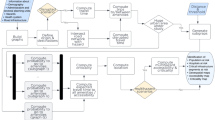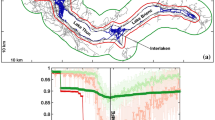Abstract
Emergency responders must reach urgent cases within mandatory timeframes, regardless of weather conditions. However, flooding of transport networks can add critical minutes to travel times between dispatch and arrival. Here, we explicitly model the spatial coverage of all Ambulance Service and Fire and Rescue Service stations in England during flooding of varying severity under compliant response times. We show that even low-magnitude floods can lead to a reduction in national-level compliance with mandatory response times and this reduction can be even more dramatic in some urban agglomerations, making the effectiveness of the emergency response particularly sensitive to the expected impacts of future increases in extreme rainfall and flood risk. Underpinning this sensitivity are policies leading to the centralization of the Ambulance Service and the decentralization of the Fire and Rescue Service. The results provide opportunities to identify hotspots of vulnerability (such as care homes, sheltered accommodation, nurseries and schools) for optimizing the distribution of response stations and developing contingency plans for stranded sites.
This is a preview of subscription content, access via your institution
Access options
Access Nature and 54 other Nature Portfolio journals
Get Nature+, our best-value online-access subscription
$29.99 / 30 days
cancel any time
Subscribe to this journal
Receive 12 digital issues and online access to articles
$119.00 per year
only $9.92 per issue
Buy this article
- Purchase on Springer Link
- Instant access to full article PDF
Prices may be subject to local taxes which are calculated during checkout






Similar content being viewed by others
Data availability
Source Data are provided with this paper. The transport network of roads in England were obtained from the UK Ordnance Survey MasterMap Integrated Transport Network (https://digimap.edina.ac.uk/). Locations of emergency service stations were collated from various sources including the UK Ordnance Survey, Ambulance trusts, Fire and Rescue Services. Although station locations were quality-checked to ensure their accuracy, there might be inconsistencies because the data came from different sources. Data were used under licence for the current study. Certain datasets are available from the lead and corresponding authors upon reasonable request and with permission of the parties that provided the data. Locations of vulnerable facilities were extracted from the UK Ordnance Survey datasets (https://digimap.edina.ac.uk/) under license. Fluvial, coastal and surface water flood risk maps were provided by the UK Environment Agency (https://data.gov.uk/publisher/environment-agency). Vulnerable population groups were derived from the 2011 England and Wales Census, available from the Office for National Statistics. Major city and town boundaries are defined by the Office for National Statistics in 201522.
References
Ngo, E. B. When disasters and age collide: reviewing vulnerability of the elderly. Nat. Disaster Rev. 2, 80–89 (2001).
Nick, G. A. et al. Emergency preparedness for vulnerable populations: people with special health-care needs. Public Health Rep. 124, 338–343 (2009).
Walker, M. et al. Children and Young People ‘After the Rain Has Gone’—Learning Lessons for Flood Recovery and Resilience Final project report for ‘Children, Flood and Urban Resilience: Understanding Children and Young People’s Experience and Agency in the Flood Recovery Process’ (Lancaster Univ., 2010); http://www.lec.lancs.ac.uk/cswm/hcfp
Lesnikowski, A., Ford, J., Biesbroek, R., Berrang-Ford, L. & Heymann, S. J. National-level progress on adaptation. Nat. Clim. Change 6, 261–265 (2015).
Adger, W. N. Vulnerability. Glob. Environ. Change 16, 268–281 (2006).
Arent, D. J. et al. in Climate Change 2014: Impacts, Adaptation, and Vulnerability (eds Field, C. B. et al.) 659–708 (Cambridge Univ. Press, 2014).
Banks, L. L., Shah, M. B. & Richards, M. E. Effective healthcare system response to consecutive Florida hurricanes. Am. J. Disaster Med. 2, 285–295 (2007).
Hess, J. J., Heilpern, K. L., Davis, T. E. & Frumkin, H. Climate change and emergency medicine: impacts and opportunities. Academic Emerg. Med. 16, 782–794 (2009).
Emergency Planning For People With Disability (Iowa Department of Public Health, 2009); https://go.nature.com/35ec6g1
Weiss, D. J. et al. A global map of travel time to cities to assess inequalities in accessibility in 2015. Nature 553, 333–336 (2018).
Coles, D., Yu, D., Wilby, R. L., Green, D. & Herring, Z. Beyond ‘flood hotspots’: modelling emergency service accessibility during flooding in York, UK. J. Hydrol. 546, 419–436 (2017).
Green, D. et al. City-scale accessibility of emergency responders operating during flood events. Nat. Hazards Earth Syst. Sci. 17, 1–16 (2017).
Dawson, R. J. et al. A systems framework for national assessment of climate risks to infrastructure. Phil. Trans. R. Soc. A 376, 20170298 (2018).
Williams, B. T., Nicholl, J. & Brazier, J. E. Health care needs assessment: accident and emergency departments. in Health Care Needs Assessment 2nd Ser. (eds Stevens, A. & Raftery, J.) (Radcliffe Medical Press, 1996).
Turner, J. et al. Ambulance Response Programme: Evaluation Of Phase 1 And Phase 2 Final report (Univ. Sheffield, 2017); https://go.nature.com/2W8G1lK
Bentham, G. Proximity to hospital and mortality from motor vehicle traffic accidents. Soc. Sci. Med. 23, 1021–1026 (1986).
Jones, A. P. & Bentham, G. Emergency medical service accessibility and outcome from road traffic accidents. Public Health 109, 169–177 (1995).
Williams, F. L. R., Lloyd, O. L. I. & Dunbar, J. A. Deaths from road traffic accidents in Scotland: 1979–1988. Does it matter where you live? Public Health 105, 319–326 (1991).
Brown, D. B. Proxy measures in accident countermeasure evaluation: a study of emergency medical services. J. Saf. Res. 11, 37–41 (1979).
Byrne, J. P. et al. Association between emergency medical service response time and motor vehicle crash mortality in the United States. JAMA Surg. 154, 286–293 (2019).
Nicholl, J., West, J., Goodacre, S. & Turner, J. The relationship between distance to hospital and patient mortality in emergencies: an observational study. Emerg. Med. J. 24, 609–609 (2007).
Major Towns and Cities (December 2015) Boundaries (UK Office for National Statistics, 2015); https://go.nature.com/2W4lbnx
Cutter, S. L. Hazards, Vulnerability And Environmental Justice 418 (Earthscan, 2006).
Maantay, J. & Maroko, A. Mapping urban risk: flood hazards, race & environmental justice in New York City. Appl. Geogr. 29, 111–124 (2009).
Walker, G. & Burningham, K. Flood risk, vulnerability and environmental justice: evidence and evaluation of inequality in a UK context. Crit. Soc. Policy 32, 216–240 (2011).
Brunkard, J., Namulanda, G. & Ratard, R. Hurricane Katrina deaths, Louisiana, 2005. Disaster Med. Public Health Prep. 2, 215–223 (2008).
Sharkey, P. Survival and death in New Orleans—an empirical look at the human impact of Katrina. J. Black Stud. 37, 482–501 (2007).
London Fire Brigade Incident Mobilisation Records (London Fire Brigade, 2016); https://go.nature.com/2SejqDs
Pregnolato, M., Ford, A., Glenis, V., Wilkinson, S. & Dawson, R. J. Potential impact of climate change on flooding disruptions to urban transport networks. J. Infrastruct. Syst. 23, 04017015 (2017a).
Pregnolato, M., Ford, A., Wilkinson, S. M. & Dawson, R. J. The impact of flooding on road transport: a depth-disruption function. Transport. Res. D 55, 67–81 (2017b).
Mahmood, M. A., Thornes, J. E., Pope, F. D., Fisher, P. A. & Vardoulakis, S. Impact of air temperature on London ambulance call-out incidents and response times. Climate 5, 61 (2017).
Fire and Rescue Incident Statistics: England, April 2016 to March 2017 Statistical Bulletin 13/17 (Home Office, 2017); https://go.nature.com/3bLtWd1
De Luca, P., Hillier, J., Wilby, R. L., Quinn, N. W. & Harrigan, S. Extreme multi-basin flooding linked with extra-tropical cyclones. Environ. Res. Lett. 12, 114009 (2017).
NHS Ambulance Services HC 972 Session 2016-17 (National Audit Office, 2017); https://go.nature.com/3bMlGcD
Report of the Joint Committee on Standards of Fire Cover by Central Fire Brigades Advisory Councils for England and Wales and Scotland (Home Office, 1985); https://go.nature.com/2xW1NkU
Risks of Flooding from Rivers and Sea (RoFRS) (Environment Agency, 2016); https://go.nature.com/2W3ERrQ
Risks of Flooding from Surface Water (RoFSW) (Environment Agency, 2013); https://go.nature.com/2zDdGwr
Office for National Statistics 2001 Census aggregate data, May 2011 (UK Data Service, 2011); https://go.nature.com/3eZhwQA
Digimap Ordnance Survey Collection, May 2018 (Ordnance Survey, 2018); https://digimap.edina.ac.uk/
Silverman, B. W. Density Estimation for Statistics and Data Analysis (Chapman and Hall, 1986).
Brown, C. & Wilby, R. L. An alternate approach to assessing climate risks. Eos 93, 401–402 (2012).
Haer, T., Wouter Botzen, W. J. & Aerts, C. J. H. Advancing disaster policies by integrating dynamic adaptive behaviour in risk assessments using an agent-based modelling approach. Environ. Res. Lett. 14, 044022 (2019).
Acknowledgements
The work was supported by the Natural Environment Research Council of the UK (grant numbers NE/R009600/1, NE/N013050/1 and NE/S017186/1); by the National Key Research and Development Program of China (grant number 2017YFE0100700); by the National Natural Science Foundation of China (grant number 41871164); and by the National Science Foundation of the United States (grant number EAR-1520683). We thank M. Oppenheimer from Princeton University for his early contribution to the methodological development of this work.
Author information
Authors and Affiliations
Contributions
D.Y. coordinated this work and wrote the first draft of the manuscript. D.Y., J.Y. and R.L.W. designed the initial method. J.C., J.C.J.H.A., S.N.L. and N.L. contributed to the further development of the methods. D.Y., J.Y. and J.C. performed the data processing and analysis. D.Y., J.Y., R.L.W., S.N.L., J.C., J.C.J.H.A. and N.L. interpreted the results and wrote the final manuscript. All authors contributed to the analysis and interpretation of results and drafting of the manuscript.
Corresponding authors
Ethics declarations
Competing interests
The authors declare no competing interests.
Additional information
Publisher’s note Springer Nature remains neutral with regard to jurisdictional claims in published maps and institutional affiliations.
Supplementary information
Supplementary Information
Supplementary Information
Source data
Source Data Fig. 2
Raw data used to generate Fig. 2.
Source Data Fig. 3
Raw data used to generate Fig. 3.
Source Data Fig. 6
Raw data used to generate Fig. 6.
Rights and permissions
About this article
Cite this article
Yu, D., Yin, J., Wilby, R.L. et al. Disruption of emergency response to vulnerable populations during floods. Nat Sustain 3, 728–736 (2020). https://doi.org/10.1038/s41893-020-0516-7
Received:
Accepted:
Published:
Issue Date:
DOI: https://doi.org/10.1038/s41893-020-0516-7
This article is cited by
-
Climate threats to coastal infrastructure and sustainable development outcomes
Nature Climate Change (2024)
-
High urban flood risk and no shelter access disproportionally impacts vulnerable communities in the USA
Communications Earth & Environment (2024)
-
Strategic storm flood evacuation planning for large coastal cities enables more effective transfer of elderly populations
Nature Water (2024)
-
From risk control to resilience: developments and trends of urban roads designed as surface flood passages to cope with extreme storms
Frontiers of Environmental Science & Engineering (2024)
-
Impacts of seasonal flooding on geographical access to maternal healthcare in the Barotse Floodplain, Zambia
International Journal of Health Geographics (2023)



